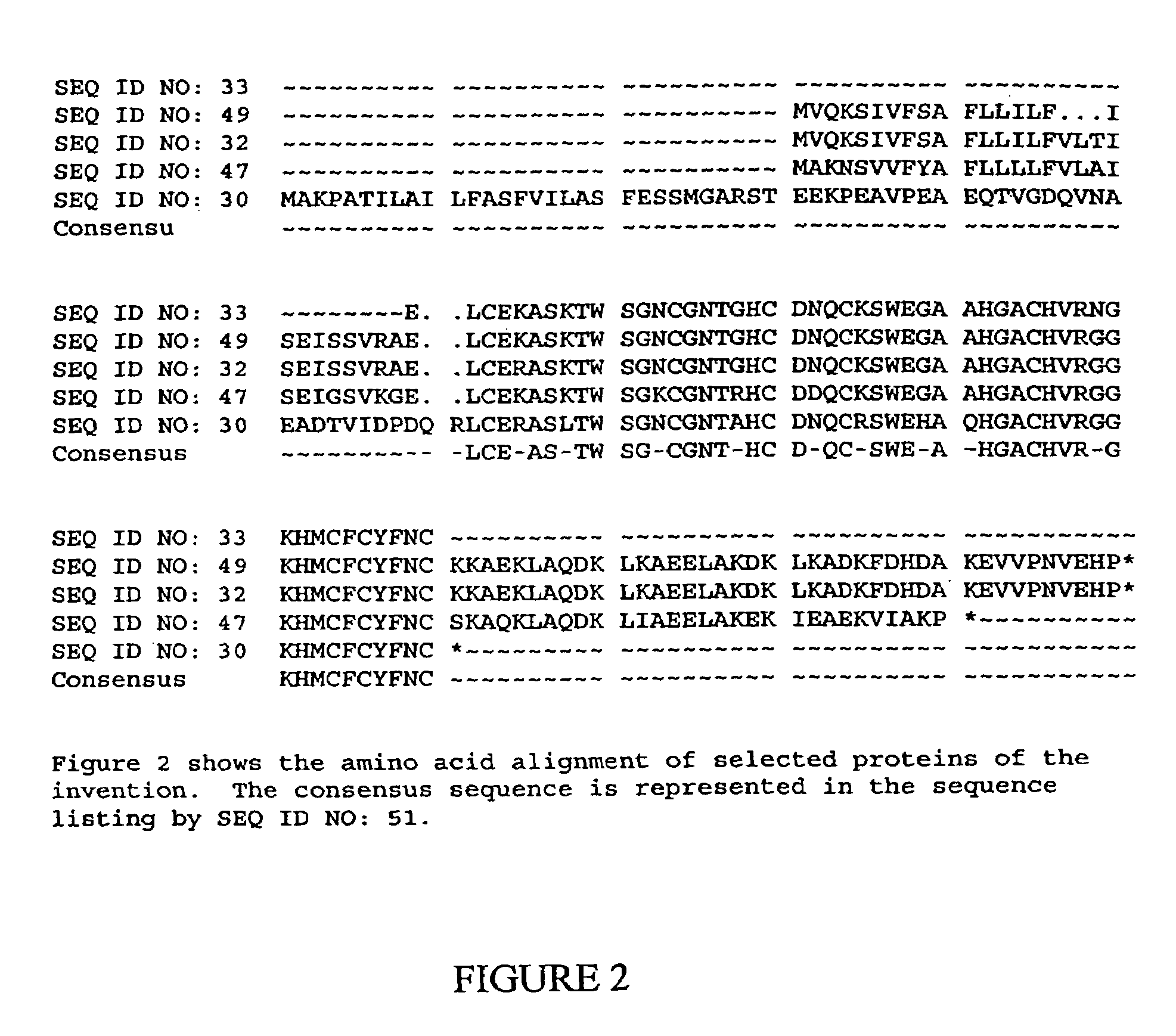Plant defensin polynucleotides and methods of use thereof
a technology of plant defensin and polynucleotides, applied in the field of plant molecular biology, can solve the problems of membrane disruption and depolarization
- Summary
- Abstract
- Description
- Claims
- Application Information
AI Technical Summary
Benefits of technology
Problems solved by technology
Method used
Image
Examples
example 1
Composition of cDNA Libraries, Isolation and Sequencing of cDNA Clones
[0193]cDNA libraries representing mRNAs from various Dimorphotheca sinuata, Picramnia pentandra, Parthenium argentatum Grey, Vernonia mespilifolia, Nicotiana benthamiana, and Helianthus annuus tissues were prepared. The characteristics of the libraries are described below.
[0194]
TABLE 2cDNA Libraries from Dimorphotheca sinuata, Picramniapentandra, Parthenium argentatum Grey, and Nicotianabenthamiana, Vernonia, and Helianthus annuusLibraryTissueClonedms2cAfrican Daisy (Dimorphotheca sinuata)dms2c.pk001.d3Developing Seedepb1cParthenium argentatum Grey Stem Barkepb1c.pk001.h15epb1c.pk002.h2epb1c.pk003.p14epb1c.pk004.p22epb1c.pk005.o6epb1c.pk006.k15epb3cParthenium argentatum Grey Stem Barkepb3c.pk009.j22ppsFlorida Bitterbush (Picramnia pentandra)pps.pk0011.a9Developing Seedpps.pk0010.g2tdr1cNicotiana benthamiana Developing Roottdr1c.pk002.g7vs1nVernonia Seed*vs1n.pk0009.h6vs1n.pk007.a9hss1cSunflower plants (Helianthus ...
example 2
Identification of cDNA Clones
[0199]cDNA clones encoding plant defensin were identified by conducting BLAST (Basic Local Alignment Search Tool; Altschul et al. (1993) J. Mol. Biol. 215:403-410) searches for similarity to sequences contained in the BLAST “nr” database (comprising all non-redundant GenBank CDS translations, sequences derived from the 3-dimensional structure Brookhaven Protein Data Bank, the last major release of the SWISS-PROT protein sequence database, EMBL, and DDBJ databases). The cDNA sequences obtained in Example 1 were analyzed for similarity to all publicly available DNA sequences contained in the “nr” database using the BLASTN algorithm provided by the National Center for Biotechnology Information (NCBI). The DNA sequences were translated in all reading frames and compared for similarity to all publicly available protein sequences contained in the “nr” database using the BLASTX algorithm (Gish and States (1993) Nat. Genet. 3:266-272) provided by the NCBI. For c...
example 3
Characterization of cDNA Clones Encoding Plant Defensin
[0201]The BLASTX search using the EST sequences from clones dms2c.pk001.d3, epblc.pk002.h2, pps.pk0011.a9 revealed similarity of the proteins encoded by the cDNAs to defensin from Dahlia merckii (NCBI GenBank Identifier (GI) No. 2147320). The BLAST results for each of these ESTs are shown in Table 3:
[0202]
TABLE 3BLAST Results for Clones Encoding PolypeptidesHomologous to Plant DefensinBLAST pLogCloneScore 2147320dms2c.pk001.d330.4epb1c.pk002.h230.3pps.pk0011.a924.0
[0203]The BLASTX search using the EST sequence from clone tdr1c.pk002.g7 revealed similarity of the protein encoded by the cDNA to defensin from Nicotiana tabacum (NCBI GI No. 676882) with a pLog value of 16.4.
[0204]The sequence of a portion of the cDNA insert from clone dms2c.pk001.d3 is shown in SEQ ID NO:1; the deduced amino acid sequence of this cDNA is shown in SEQ ID NO:2. The sequence of a portion of the cDNA insert from clone epb1c.pk002.h2 is shown in SEQ ID N...
PUM
| Property | Measurement | Unit |
|---|---|---|
| Tm | aaaaa | aaaaa |
| Tm | aaaaa | aaaaa |
| Tm | aaaaa | aaaaa |
Abstract
Description
Claims
Application Information
 Login to View More
Login to View More - R&D
- Intellectual Property
- Life Sciences
- Materials
- Tech Scout
- Unparalleled Data Quality
- Higher Quality Content
- 60% Fewer Hallucinations
Browse by: Latest US Patents, China's latest patents, Technical Efficacy Thesaurus, Application Domain, Technology Topic, Popular Technical Reports.
© 2025 PatSnap. All rights reserved.Legal|Privacy policy|Modern Slavery Act Transparency Statement|Sitemap|About US| Contact US: help@patsnap.com



